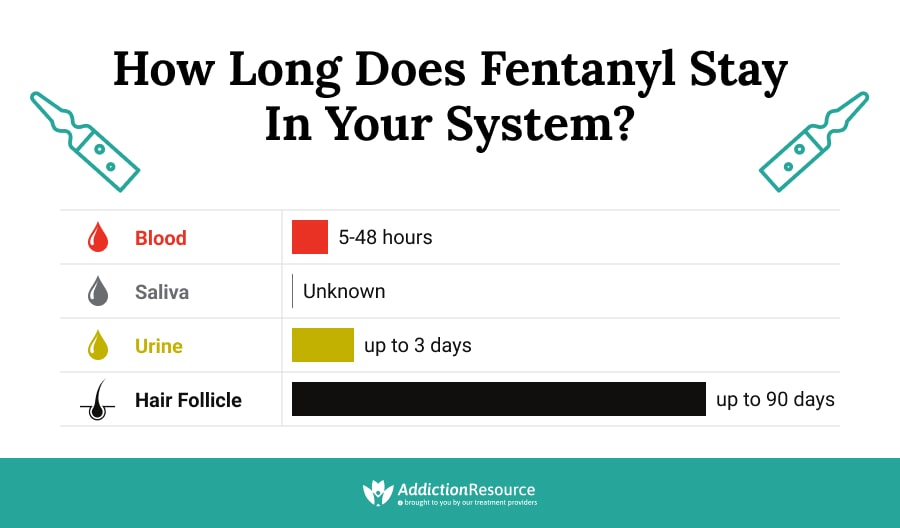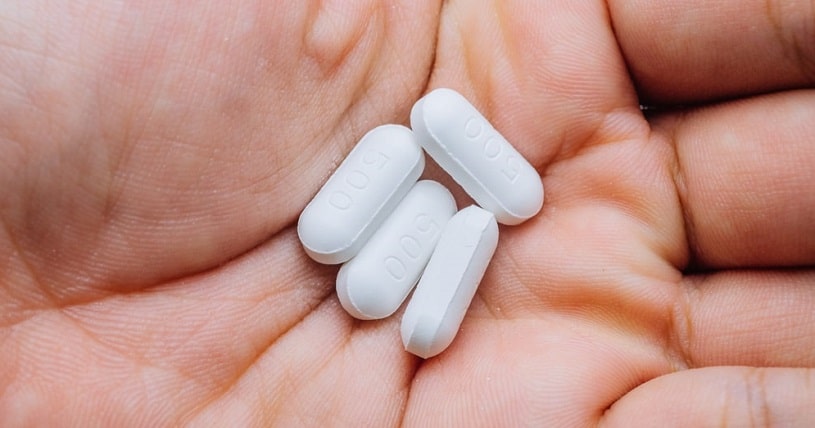Fentanyl is an opioid most commonly prescribed to people who suffer from severe pain episodes. This drug is a Schedule II medication, which means that it has a high potential for abuse. Similar to morphine and heroin, it activates the brain receptors responsible for the sensation of euphoria. Fentanyl half-life, which largely controls how long it will stay in human systems, is usually affected by factors like dosage, age, and frequency of use. Learn more about half-life of fentanyl and its detection times in various drug tests.
Table Of Contents:
How Long Does Fentanyl Stay in Your System?
Like fentanyl half-life differs by ingestion routes, so is there a difference in the substance’s duration in different parts of the body. Knowing how long it stays in blood, urine, saliva, and hair helps determine where to take samples from for fentanyl drug tests, especially when outside the controlled postoperative setting.
A fentanyl drug test cannot be done using standard drug tests, according to a study carried out by the Centers for Disease Control and Prevention. This is because while standard drug tests often aim to detect opioids that metabolize into morphine, fentanyl does not metabolize into morphine. For this reason, its detection is specific to specialized tests. Samples for these tests can be taken from different locations. These samples include:
Blood
Blood samples can be obtained for a fentanyl drug test if a person can’t give a urine sample. A blood test can detect the substance’s presence 5 to 48 hours after the last dose.
Urine
A urine test is a non-invasive, safe way to determine whether someone is using this substance. The drug can be detected quickly after ingestion. It is detectable through a urine test conducted up to 3 days after the last dose.
Saliva
Saliva is rarely used as a sample for fentanyl drug tests due to low accuracy.
Hair
Hair analysis provides a long detection window; it can detect the drug up to 3 months after the last dose.
False Positive
False positives occur when a person tests positive for a substance they have not taken. The same happens when a fentanyl drug test is done. False positives happen when there is cross-reactivity between molecules in samples taken and the antibody in the EIA, Enzyme ImmunoAssay test. These molecules are usually from medications like quinolone antibiotics, rifampin, and verapamil, among others.

Opioid Metabolism
25% of the drug is absorbed in a user’s mouth via buccal mucosa. The rest of the medication (75%) is absorbed in the gastrointestinal tract. After the absorption, the substance is distributed to the heart, brain, kidneys, lungs, and spleen. Also, some of it can be deposited in fat tissue. It is metabolized in the liver by the CYP3A4 enzyme. 90% of it is excreted through urine in the form of metabolites.

What Does Fentanyl Do?
On absorption, fentanyl mechanism of action involves molecules binding to opioid receptors, particularly the μ-opioid receptor. These receptors are majorly localized in the brain and are within neuroanatomical structures regarded as the control-seat of emotions, pain, and reward, which is the point of its addictive properties.
Activation of these receptors reduces cAMP (Cyclic adenosine monophosphate) concentration, which is a second messenger used for intracellular signal transduction. This transduction, which is the process by which foreign DNA is introduced into a cell, includes transferring the effects of hormones into cells. This reduced cAMP decreases the cAMP-dependent influx of calcium ions into the cell. These lead to an inhibition of nerve activity. It explains why it is used as an analgesic in clinical settings.
Fentanyl Half-Life
Fentanyl half-life is the time between the maximum concentrations of the substance in a human body and half the maximum concentration. Knowing this helps measure the removal rate and monitor the body’s self-cleansing ability through the kidney, livers, and intestines.
Fentanyl half-life is around 8-10 hours.
According to the study published by National Center for Biotechnology Information, NCBI journal, fentanyl half-life is affected by administration routes as different routes: transdermal patch, buccal, intranasal, IV, spray, etc., have different delivery rates of delivery into the system. These deliveries can take place within or without the regulations of clinical limits. This difference in delivery rates also affects the detection times.

The test results usually don’t depend on whether the drug was administered in a controlled setting as analgesia.
Factors That Influence the Elimination Time
Like fentanyl half-life depicts, this substance stays in human systems for certain periods of time. However, the elimination times differ from person to person. Several factors could be responsible for the different duration in one’s body.
They Include:
- Age. It is proven that older users tend to metabolize this substance much slower than younger ones. According to research, drug elimination in one group of patients younger than 50 was 265 minutes, and in that of patients older than 60, it took 945 minutes.
- Body type. People with a higher percentage of body fat metabolize drugs longer than users with low body fat index because they have less fatty tissue where accumulation can occur.
- Liver function. Most of the drug is metabolized in the liver by the CYP3A4 enzyme. People who have cirrhosis or other hepatic conditions tend to eliminate it slower than healthy individuals.
- Genetics. Some people are genetically predisposed to metabolize this drug much slower than others. Several alleles of CYP3A4 are responsible for its low metabolism.
- Hydration. Keeping in mind that most of the substance is eliminated through urine, it is clear that proper hydration can shorten the time needed to thoroughly eliminate the drug.
- Metabolic rate. It is commonly known that people with a higher basal metabolic rate (BMR) burn more energy during rest. Therefore, higher BMR can have a positive impact on the excretion time.
- Route of administration. There are three routes of its administration—intravenous, transmucosal, and transdermal. For intravenous users, it takes 11 to 22 hours to eliminate it from blood plasma. When it comes to transmucosal users, it takes up to 3.4 days to remove the drug, and for transdermal users, elimination time can last more than five days.
- Dosage and frequency of use. The greater the dose taken, the more time it will take to excrete it from the system.
- Combination with other drugs. Combining it with other medications, especially with CYP3A4 inhibitors, may harm its excretion.

Fentanyl is a potent opioid, and many factors can influence its elimination from the system, such as age, dosage and even ingestion route. However, if one is concerned about not testing positive for this drug, it can be dangerous to quit cold turkey. The most effective way is tapering off slowly under medical supervision. Treatment centers have all the necessary tools to help a patient go through fentanyl withdrawal safely and without complications. If one is worried about an addiction that has already developed in them or their loved one, enrolling in an inpatient treatment program is a good way to overcome it.
Hope Without Commitment
Find the best treatment options. Call our free and confidential helpline
Most private insurances accepted
Page Sources
- Carlos F. Ramos-Matos; Karlyle G. Bistas; Wilfredo Lopez-Ojeda. Fentanyl. https://www.ncbi.nlm.nih.gov/books/NBK459275/
- Evan D. Kharasch. Opioid half-lives and hemlines: The long and short of fashion. https://www.ncbi.nlm.nih.gov/pmc/articles/PMC4439340/
- Zachary Dezman, Bradford Schwartz, Amy Billing, Ebonie Massey, Erin Artigiani, Julie Factor; Eric D. Wish, Notes from the Field: High Prevalence of Fentanyl Detected by the Maryland Emergency Department Drug Surveillance System — Baltimore, Maryland, 2019. https://www.cdc.gov/mmwr/volumes/69/wr/mm6923a3.htm
- Christopher J. Keary, MD, Ying Wang, MD, Jonathan R. Moran, MD, MBA, Lazaro V. Zayas, MD, and Theodore A. Stern, MD. Toxicologic Testing for Opiates: Understanding False-Positive and False-Negative Test Results. https://www.ncbi.nlm.nih.gov/pmc/articles/PMC3505132/
- J B Bentley, J D Borel, R E Nenad Jr, T J Gillespie, Age and fentanyl pharmacokinetics https://www.ncbi.nlm.nih.gov/pubmed/7149300
- Howard S. Smith, Opioid Metabolism, 2009. https://www.ncbi.nlm.nih.gov/pmc/articles/PMC2704133/
- G Cheymol, Effects of obesity on pharmacokinetics implications for drug therapy, 2020. https://pubmed.ncbi.nlm.nih.gov/11020136/

 Authored by
Authored by  Reviewed by
Reviewed by 

